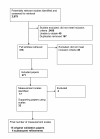A methodological review of resilience measurement scales
- PMID: 21294858
- PMCID: PMC3042897
- DOI: 10.1186/1477-7525-9-8
A methodological review of resilience measurement scales
Abstract
Background: The evaluation of interventions and policies designed to promote resilience, and research to understand the determinants and associations, require reliable and valid measures to ensure data quality. This paper systematically reviews the psychometric rigour of resilience measurement scales developed for use in general and clinical populations.
Methods: Eight electronic abstract databases and the internet were searched and reference lists of all identified papers were hand searched. The focus was to identify peer reviewed journal articles where resilience was a key focus and/or is assessed. Two authors independently extracted data and performed a quality assessment of the scale psychometric properties.
Results: Nineteen resilience measures were reviewed; four of these were refinements of the original measure. All the measures had some missing information regarding the psychometric properties. Overall, the Connor-Davidson Resilience Scale, the Resilience Scale for Adults and the Brief Resilience Scale received the best psychometric ratings. The conceptual and theoretical adequacy of a number of the scales was questionable.
Conclusion: We found no current 'gold standard' amongst 15 measures of resilience. A number of the scales are in the early stages of development, and all require further validation work. Given increasing interest in resilience from major international funders, key policy makers and practice, researchers are urged to report relevant validation statistics when using the measures.
References
-
- Friedli L. Mental health, resilience and inequalities. Denmark: World Health Organisation; 2009. http://www.euro.who.int/document/e92227.pdf
-
- The Scottish Government. Equally well. Report of the Ministerial Task Force on Health Inequalities. Vol. 2. Edinburgh: The Scottish Government; 2008. http://www.scotland.gov.uk/Publications/2008/06/09160103/0
-
- Medical Research Council. Lifelong health and well-being. 2010. http://www.mrc.ac.uk/Ourresearch/ResearchInitiatives/LLHW/index.htm#P61_...
Publication types
MeSH terms
Grants and funding
LinkOut - more resources
Full Text Sources
Medical
Molecular Biology Databases


